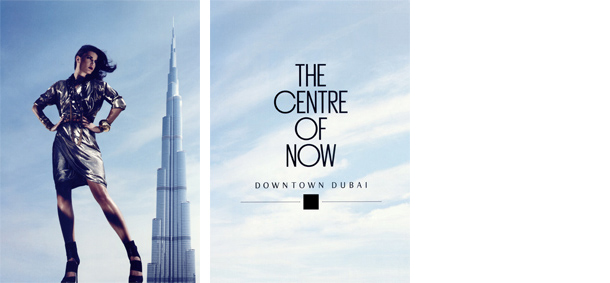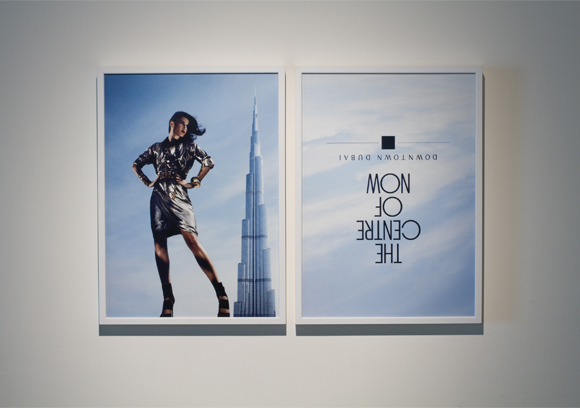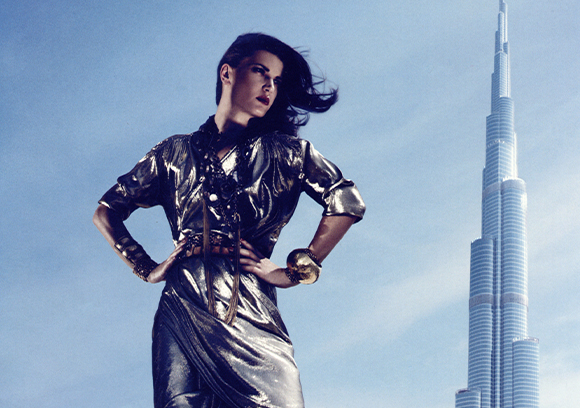| |
|
|
25.
| The Center of Now |
| |


2010-2011, inkjet print, 50 x 70 cm.
Exhibition view from Megalopolis, AKBank Sanat, 2011, Istanbul.
Courtesy of the artist and Lawrie Shabibi, Dubai.
Ed. of 5 + 2 A.P.
'' mounir fatmi exposes what lies behind the scenes by using a Brechtian technique that reveals the manipulations of the stage director,
the effects of optical illusions and above all the objective of the entire production: to seduce the viewer. ''
Studio Fatmi, February 2017

The Center of Now
Exhibition view from Megalopolis, AKBank Sanat, 2011, Istanbul.
Courtesy of the artist.

The Center of Now
Exhibition view from Megalopolis, AKBank Sanat, 2011, Istanbul.
Courtesy of the artist.
|
|
|
|
|
|
« Le Centre d’aujourd'hui" est un work in progress photographique inspiré des campagnes publicitaires de promotion urbanistique. L'œuvre explore le rôle de l'architecture et de l'urbanisation dans les changements sociaux des pays du Golfe et observe la transformation en profondeur des sociétés arabes traditionnelles par les grands projets architecturaux de la dernière décennie. Cette transformation est également évoquée dans des œuvres telles que « Le Changement fondamental », « Speed city », « Babel house » ou encore « Skyline ». Les photographies s'intéressent aux interactions entre formes d'organisations sociales traditionnelles et formes contemporaines sous les aspects de sociétés de la consommation, de l'image et de l'information. Elles s'interrogent sur la manière dont les sociétés traditionnelles concilient leurs valeurs et les enjeux de la mondialisation économique et culturelle.
La photographie « Le Centre d’aujourd’hui » (2010-2011) s'intéresse en particulier à la promotion d'un vaste projet urbanistique, immobilier et architectural : le « Downtown Dubaï », autrement nommé « Downtown Burj Khalifa Dubaï ». Ce nouveau quartier de Dubaï, apparu entre 2000 et 2010, se situe au sud du centre historique de la ville et comprend la tour Burj Khalifa, le plus haut gratte-ciel du monde avec 830 mètres de hauteur, ainsi que de très nombreux bâtiments de grandes dimensions. L'œuvre photographique met en scène la femme qui est représentée dans les affiches de la campagne de promotion, la tour Burj Khalifa et le slogan publicitaire « The city of now ».
« Le Centre d’aujourd’hui » détourne une photographie extraite de la campagne publicitaire, en la modifiant à peine. La photo d'origine se présente en effet comme une seule image prise en contre-plongée, qui fait apparaître une femme au premier plan, juchée sur des talons hauts, mains sur les hanches, dans une pose stylisée de mannequin. Derrière elle se déroule la skyline du Downtown Dubaï, composée de divers immeubles, et surtout de la fameuse tour Burj Khalifa qui se hisse tout en haut de l'image, dépassant la silhouette féminine, au milieu d'un ciel bleu où des nuages effilés semblent suivre le regard de la femme. La droite de l'image est occupée par le slogan publicitaire inscrit en grands caractères. Le détournement photographique opéré par mounir fatmi rompt la belle unité stylistique de la photographie d'origine et commence par transformer le plan unique en dyptique.
La stratégie artistique de mounir fatmi procède tout à tour par scission, focalisation et inversion. A la simplicité et à l'évidence du message publicitaire, il oppose la simplicité d'un traitement artistique. Après scission, le panneau de gauche se trouve uniquement occupé par la femme et la tour Burj Khalifa, tandis que les autres bâtiments ont disparu de l'image. La photographie se focalise sur les principaux acteurs de la publicité en supprimant les détails inutiles qui pourraient égarer le spectateur dans son projet de découvrir les enjeux qui sous-tendent le projet d'urbanisation. Le plan se resserre autour des protagonistes principaux : la femme et la tour, l'objet du désir et le lieu de sa possible réalisation.
Les images publicitaires reprennent les codes du marketing contemporain, employés partout dans le monde : représentation de la femme objet de désir, suggestion d'une équivalence entre la femme désirable et le produit en vente, ici le centre commercial ouvert à toute heure, érection architecturale et phallique comme symbole de puissance. Le panneau droit applique malicieusement une rotation à l'image et se contente de faire apparaître le slogan publicitaire à l'envers. Son propos tend à s'inverser : le centre d'aujourd'hui ne risque-t-il pas, en cédant à un effet de mode architecturale, de devenir un nulle part anachronique?
mounir fatmi expose l'envers du décor au moyen d'une réalisation brechtienne qui révèle les manipulations du metteur en scène, les jeux d'illusion d'optique et surtout les enjeux de la mise en scène, à savoir la séduction du spectateur. L'œuvre fonctionne dans l'univers artistique de mounir fatmi comme un piège esthétique : elle séduit et en même temps délivre une leçon sur la juste distance à tenir face à la séduction exercée par les discours publicitaires. La stratégie du message publicitaire est évidente et les équivalences qu'elle pose sont grossières et cependant son propos est tellement évident qu'il peut être facile d'y adhérer sans recul. mounir fatmi intervient à peine sur l'image tant l'évidence saute aux yeux. Et pourtant ces interventions n'en sont pas moins nécessaires afin d'obtenir la distance nécessaire à la révélation des artifices.
L'intervention de mounir fatmi sur la photographie d'origine se remarque à peine. Et pourtant, à l'aide d'opérations de transformations minimales de l'image, il identifie ses effets essentiels en les inversant ironiquement : la séduction du départ se transforme en inquiétude et le spectateur ne peut s'empêcher de se demander si toutes ces splendeurs architecturales ne dissimulent pas quelque chose d'inquiétant… La photographie « Le Centre d’aujourd’hui » désigne un endroit qui se trouve partout et nulle part sur la planète, un point central dans la mesure où il est le lieu de l'obsession pour l'image et du consumérisme, de l'accès immédiat et illusoire à l'objet de nos désirs. Elle évoque une transformation sociale aux effets ambivalents, incertains, voire contradictoires : il observe la place de la femme changer dans la société arabe traditionnelle, l'ouverture nouvelle sur le monde et les autres cultures dont cette société fait preuve et en même temps constate que le pouvoir des puissances financières est réaffirmé, que la position dominante du patriarcat est confirmé, ou encore que la propagation du consumérisme ne connaît pas de frontière.
Studio Fatmi, février 2017.
|
|
« The Centre of Now » is a photographic work in progress inspired by advertising campaigns for urban projects. The piece explores the role of architecture and urbanization in social changes in the Gulf countries and observes the deep transformation of traditional Arab societies through large-scale architectural projects over the course of the last decade. This transformation is also touched upon in pieces such as « The Fundamental Change », « Speed City », « Babel House » and « Skyline ». The photographs look at the interactions between traditional and contemporary forms of social organizations through the perspective of the consumer society, appearances and information. They question the way traditional societies reconcile their values with the challenges posed by economic and cultural globalization.
Specifically, the photograph « The Centre of Now » (2010-2011) looks at the promotion of a large urban, real estate and architectural project, « Downtown Dubai », also known as « Downtown Burj Khalifa Dubai ». This new neighborhood, built between 2000 and 2010, is located south of the historical city center and comprises the famous Burj Khalifa tower, the world’s tallest skyscraper reaching a height of 830 meters, along with many other large buildings. The photograph shows the woman presented in the posters used for the project’s promotional campaign, the Burj Khalifa tower and the slogan « The City of Now ».
« The Center of Now » twists a photograph used in that advertising campaign, but only slightly modifies it. The original photograph presents itself as one single image taken with a low-angle shot, showing a woman in the foreground wearing high heels, hands on her hips, in a stylized mannequin pose. Behind her, the Downtown Dubai skyline is visible, with its many buildings, among which the famous Burj Khalifa, towering over the image, taller than the woman’s silhouette, in the middle of a blue sky where thin clouds seem to follow the woman’s gaze. On the right of the image, the advertising slogan is written in large print. The twisting of the photograph conducted by mounir fatmi breaks the image’s harmonious stylistic unity first of all by turning it into a diptych.
mounir fatmi’s artistic strategy successively resorts to separation, focalization and inversion. It opposes the simplicity of an artistic treatment to the simplicity and obviousness of the advertising message. After the separation, the left panel is only occupied by the woman and the Burj Khalifa tower; the other buildings have disappeared. The photograph thus focuses on the main characters in the ad by removing all the useless details that could distract viewers in their intention to discover the stakes underlying this urbanization project. The shot zooms in on the main characters: the woman and the tower, the object of desire and the place of its potential realization.
Advertising images use the codes of contemporary marketing that are employed around the world: representing a woman as an object of desire, suggesting an equivalence between the desirable woman and the sold product – in this case a shopping center open all day, an architectural and phallic erection as a symbol of power. The right panel maliciously rotates the image and only shows the advertising slogan upside down. Its message tends to be inverted: doesn’t the center of today, giving in to an architectural fad, run the risk of becoming an anachronistic nowhere?
mounir fatmi exposes what lies behind the scenes by using a Brechtian technique that reveals the manipulations of the stage director, the effects of optical illusions and above all the objective of the entire production: to seduce the viewer. The work acts within mounir fatmi’s artistic universe like an esthetic trap: it seduces and simultaneously delivers a lesson on the right distance to keep vis-à-vis the seduction exercised by advertising messages. The strategy of the advertising message is obvious and the equivalences it suggests are basic, yet its discourse is so obvious that it can be easy to blindly adhere to it. The obviousness is so plain to see that Mounir Fatmi hardly intervenes in the image, but these interventions are nonetheless necessary in order to create the required distance to reveal the artifacts.
mounir fatmi’s intervention on the original photograph is hardly noticeable. But through minimal transformations in the image, he identifies its essential effects by ironically inverting them: the initial seduction is turned into concern, and the viewer can’t help but wonder whether all these architectural marvels hide something worrying… The photograph « The Centre of Today » designates a place that is everywhere and nowhere in the world, a central spot in the sense that it is a place where the obsessions are appearances, consumption and the immediate and illusory satisfaction of our desires. It evokes a social transformation that has ambivalent, uncertain and perhaps contradictory effects: it sees the changes in the status of women in traditional Arab societies, a new openness towards the world and other cultures, while at the same time noticing that the power of financial institutions is solidified, that the dominant position of patriarchy is confirmed and that the propagation of consumerism knows no borders.
Studio Fatmi, February 2017. |
|
|
|